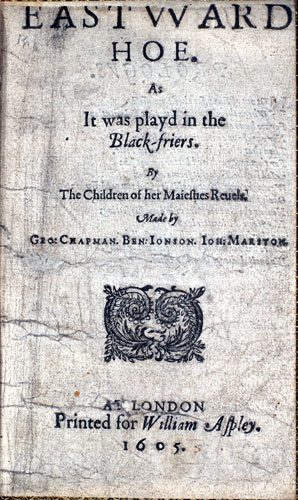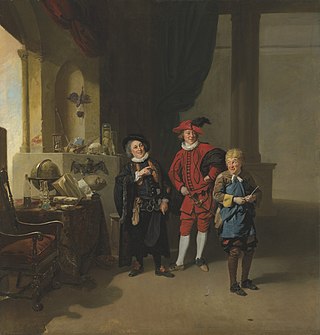
Benjamin Jonson was an English playwright and poet. Jonson's artistry exerted a lasting influence on English poetry and stage comedy. He popularised the comedy of humours; he is best known for the satirical plays Every Man in His Humour (1598), Volpone, or The Fox, The Alchemist (1610) and Bartholomew Fair (1614) and for his lyric and epigrammatic poetry. "He is generally regarded as the second most important English dramatist, after William Shakespeare, during the reign of James I."

Eastward Hoe or Eastward Ho! is an early Jacobean-era stage play written by George Chapman, Ben Jonson and John Marston. The play was first performed at the Blackfriars Theatre by a company of boy actors known as the Children of the Queen's Revels in early August 1605, and it was printed in September the same year.

The Masque of Blackness was an early Jacobean era masque, first performed at the Stuart Court in the Banqueting Hall of Whitehall Palace on Twelfth Night, 6 January 1605. It was written by Ben Jonson at the request of Anne of Denmark, the queen consort of King James I, who wished the masquers to be disguised as Africans. Anne was one of the performers in the masque along with her court ladies, all of whom appeared in blackface makeup. In a ceremony earlier on the day, Prince Charles, Anne's second son was given the title of Duke of York.

The Alchemist is a comedy by English playwright Ben Jonson. First performed in 1610 by the King's Men, it is generally considered Jonson's best and most characteristic comedy; Samuel Taylor Coleridge believed that it had one of the three most perfect plots in literature. The play's clever fulfilment of the classical unities and vivid depiction of human folly have made it one of the few Renaissance plays with a continuing life on stage, apart from a period of neglect during the Victorian era.
Epicœne, or The Silent Woman, also known as Epicene, is a comedy by Renaissance playwright Ben Jonson. The play is about a man named Dauphine, who creates a scheme to get his inheritance from his uncle Morose. The plan involves setting Morose up to marry Epicoene, a boy disguised as a woman. It was originally performed by the Blackfriars Children, or Children of the Queen's Revels, a group of boy players, in 1609. Excluding its two prologues, the play is written entirely in prose.
The Masque of Queens, Celebrated From the House of Fame is one of the earlier works in the series of masques that Ben Jonson composed for the House of Stuart in the early 17th century. Performed at Whitehall Palace on 2 February 1609, it marks a notable development in the masque form, in that Jonson defines and elaborates the anti-masque for the first time in its pages.

The City Madam is a Caroline era comedy written by Philip Massinger. It was licensed by Sir Henry Herbert, the Master of the Revels, on 25 May 1632 and was acted by the King's Men at the Blackfriars Theatre. It was printed in quarto in 1658 by the stationer Andrew Pennycuicke, who identified himself as "one of the Actors" in the play. A second edition followed in 1659. Pennycuicke dedicated the play to Ann, Countess of Oxford—or at least most of the surviving copies bear a dedication to her; but others are dedicated to any one of four other individuals.
The Court Beggar is a Caroline era stage play written by Richard Brome. It was first performed by the acting company known as Beeston's Boys at the Cockpit Theatre. It has sometimes been identified as the seditious play, performed at the Cockpit in May 1640, which the Master of the Revels moved to have suppressed. However, the play's most recent editor, Marion O'Connor, dates it to "no earlier than the end of November 1640, and perhaps in the first months of 1641".
The New Inn, or The Light Heart is a Caroline era stage play, a comedy by English playwright and poet Ben Jonson.
The Devil Is an Ass is a Jacobean comedy by Ben Jonson, first performed in 1616 and first published in 1631.

Hymenaei, or The Masque of Hymen, was a masque written by Ben Jonson for the marriage of Robert Devereux, 3rd Earl of Essex, and Lady Frances Howard, daughter of the Earl of Suffolk, and performed on their wedding day, 5 January 1606. The costumes, sets, and scenic effects were designed by Inigo Jones, and the music composed by Alfonso Ferrabosco.
The Staple of News is an early Caroline era play, a satire by Ben Jonson. The play was first performed in late 1625 by the King's Men at the Blackfriars Theatre, and first published in 1631.
A Tale of a Tub is a Caroline era stage play, a comedy written by Ben Jonson. The last of his plays to be staged during his lifetime, A Tale of a Tub was performed in 1633 and published in 1640 in the second folio of Jonson's works.

Ben Jonson collected his plays and other writings into a book he titled The Workes of Benjamin Jonson. In 1616 it was printed in London in the form of a folio. Second and third editions of his works were published posthumously in 1640 and 1692.
The Example is a Caroline era stage play, a comedy written by James Shirley, first published in 1637. The play has repeatedly been acclaimed both as one of Shirley's best comedies and one of the best works of its generation. And it provides one of the clearest demonstrations in Shirley's canon of the influence of the works of Ben Jonson on the younger dramatist's output.
The Wild Gallant is a Restoration comedy written by John Dryden. It was Dryden's earliest play, and written in prose, except for the prologue, and the epilogue, which are in verse. It was premiered on the stage by the King's Company at their Vere Street theatre, formerly Gibbon's Tennis Court, on February 5, 1663. As Dryden himself stated in his Preface, it was "the first attempt I made in Dramatique Poetry."
The City Wit, or the Woman Wears the Breeches is a Caroline era stage play, a comedy written by Richard Brome that is sometimes classed among his best works. It was first published when it was included in the Five New Plays of 1653, the collection of Brome works published by Humphrey Moseley, Richard Marriot, and Thomas Dring.
A Mad Couple Well-Match'd is a Caroline era stage play, a comedy written by Richard Brome. It was first published in the 1653 Brome collection Five New Plays, issued by the booksellers Humphrey Moseley, Richard Marriot, and Thomas Dring.
The Parson's Wedding is a Caroline era stage play, a comedy written by Thomas Killigrew. Often regarded as the author's best play, the drama has sometimes been considered an anticipation of Restoration comedy, written a generation before the Restoration; "its general tone foreshadows the comedy of the Restoration from which the play is in many respects indistinguishable."
Pamphilia to Amphilanthus is a sonnet sequence by the English Renaissance poet Lady Mary Wroth, first published as part of The Countess of Montgomery's Urania in 1621, but subsequently published separately. It is the second known sonnet sequence by a woman writer in England. The poems are strongly influenced by the sonnet sequence Astrophel and Stella (1580) penned by her uncle Sir Philip Sidney. Like Sidney's sequence, Wroth's sonnets passed among her friends and acquaintances in manuscript form before they were published in 1621. In Wroth's sequence, she upends Petrarchan tropes by making the unattainable object of love male.






